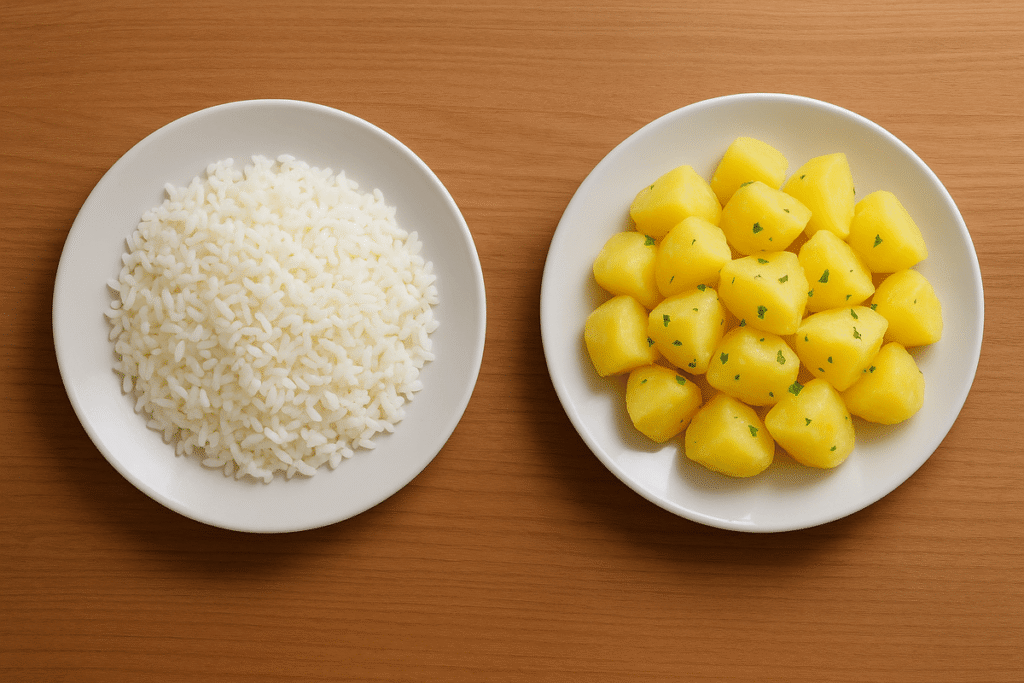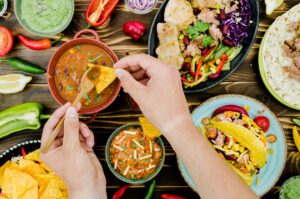When it comes to weight loss, many individuals are curious about the best carbohydrate sources to include in their diet.
Two popular choices are rice and potatoes, but which one is better for weight loss?
Both rice and potatoes are starchy foods that provide a good source of energy, but they differ in several important ways.
This article will help you understand the differences between rice and potatoes and which might be the better option for your weight loss goals.
Rice or Potatoes for Weight Loss: Which is the Better Option?
When choosing between rice or potatoes for weight loss, it’s important to look at their nutritional profiles and how they impact satiety and blood sugar.
Rice, especially white rice, is a refined carbohydrate with fewer nutrients compared to its whole grain counterpart, brown rice.
Potatoes, on the other hand, are a whole food that retains more of its fiber and nutrients, especially when eaten with the skin.
The decision depends on how you incorporate these foods into your overall diet and their effects on your hunger levels and blood sugar.
The Nutritional Profiles of Rice and Potatoes
Rice and potatoes both provide a significant amount of carbohydrates, but the way they affect your diet can differ.
White rice contains about 200 calories per cup and provides around 45 grams of carbohydrates, with less than 1 gram of fiber.
Brown rice has more fiber, with about 3.5 grams per cup, and contains more micronutrients such as magnesium and B vitamins.
Potatoes, a versatile vegetable, contain about 110 calories per medium-sized potato and provide around 26 grams of carbohydrates and 2 grams of fiber.
They are also an excellent source of vitamin C and potassium, which play a role in heart health and immune function.
While rice and potatoes both have their benefits, potatoes tend to be the more nutrient-dense choice, especially when consumed with the skin.
How Rice and Potatoes Affect Blood Sugar Levels
One important factor to consider when choosing between rice and potatoes for weight loss is their effect on blood sugar levels.
White rice has a high glycemic index (GI), meaning it is quickly digested and causes a sharp spike in blood sugar.
This can lead to an increase in insulin production, which may contribute to fat storage over time.
Brown rice, with its higher fiber content, has a lower GI and causes a more gradual increase in blood sugar.
Potatoes, particularly when cooked and cooled (like in potato salad), can have a lower GI compared to freshly cooked potatoes.
However, the method of preparation can affect the glycemic index, and choosing a healthier cooking method can help mitigate the spike in blood sugar.
Overall, brown rice and cooled potatoes are more favorable for weight loss due to their lower glycemic response.
Which is Better for Satiety and Appetite Control?
When it comes to controlling hunger and reducing overall calorie intake, satiety plays a critical role.
Both rice and potatoes have their place in a weight loss plan, but the ability to keep you feeling full can vary.
Potatoes are known to be more filling compared to rice, partly because of their fiber content and water content, especially in the skin.
Studies have shown that people tend to feel fuller for longer after eating potatoes, which may reduce the temptation to snack on high-calorie foods later on.
Rice, while still providing some level of satiety, doesn’t have the same filling effect as potatoes, especially white rice.
For weight loss, choosing foods that help keep hunger at bay, like potatoes, may be the key to reducing calorie consumption throughout the day.
How to Incorporate Rice and Potatoes into a Weight Loss Diet
Both rice and potatoes can be part of a healthy weight loss diet, as long as they are consumed in moderation and paired with nutrient-dense foods.
Opt for brown rice over white rice to increase fiber intake and slow down the absorption of carbohydrates.
Incorporate a variety of vegetables with your potatoes to increase fiber and add more nutrients to your meal.
Avoid frying potatoes or adding excessive amounts of butter, cheese, or sour cream, as these can quickly add unnecessary calories.
Instead, try roasting, boiling, or baking potatoes with minimal added fats for a healthier option.
Incorporating both rice and potatoes into a balanced meal with lean proteins and healthy fats can support weight loss without depriving you of energy or important nutrients.
Healthier Ways to Prepare Rice and Potatoes
How you prepare rice and potatoes is just as important as the choice of food itself.
For rice, consider opting for brown rice, wild rice, or other whole grains for added fiber and nutrients.
If you’re preparing white rice, try mixing it with vegetables or a source of protein to balance the meal and slow down digestion.
For potatoes, avoid deep frying and opt for healthier cooking methods like roasting, steaming, or boiling.
To boost the nutritional value, leave the skins on potatoes to retain more fiber and nutrients.
Incorporating herbs, spices, and minimal olive oil instead of butter or heavy sauces can make both rice and potatoes healthier without adding excess calories.
Final Thoughts on Rice or Potatoes for Weight Loss
When choosing between rice or potatoes for weight loss, both foods can be part of a healthy diet when prepared correctly and consumed in moderation.
Rice, especially brown rice, is a good source of fiber and essential nutrients, but potatoes provide more satiety and beneficial vitamins.
For effective weight loss, focusing on whole, nutrient-dense foods and controlling portion sizes is key.
Whether you choose rice or potatoes, the most important factor is how they fit into a balanced, healthy diet.
Incorporating a balanced approach to carbohydrates, such as choosing brown rice or nutrient-rich potatoes, is important for sustainable weight loss.
Additionally, consider supporting your metabolism with a natural supplement like OrexiBurn, which helps regulate appetite and support healthy metabolism.
To learn more about how OrexiBurn can enhance your weight loss journey, visit the official OrexiBurn website today.









